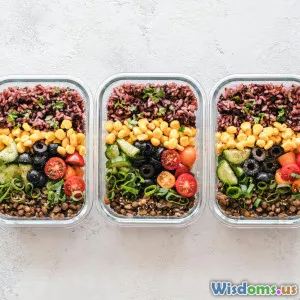
My 30Day Challenge Kids Tried a New Healthy Food Each Day
7 min read Discover how a 30-day challenge inspired kids to try new healthy foods daily, transforming mealtime and nutrition habits. (0 Reviews)
My 30-Day Challenge: Kids Tried a New Healthy Food Each Day
Introduction
How do you get kids excited about eating healthy foods? For many parents, it's a challenge as familiar as bedtime struggles or homework battles. Few things test creativity — and patience — like encouraging children to experiment with tastes beyond chicken nuggets and fries. To tackle this, I launched a 30-day challenge with my kids to try a new healthy food every single day. What followed was a surprising adventure brimming with colorful vegetables, nutrient-packed fruits, and even some odd yet delicious discoveries.
This article shares the journey, insights gained, strategies that worked, and lessons for families seeking to boost their children's nutritional intake with variety and fun.
Why Attempt a Daily New Food Challenge?
Introducing variety into kids' diets plays a crucial role in preventing nutritional gaps, expanding palates, and lowering fussiness. According to the American Academy of Pediatrics, diverse diets in childhood support healthy growth and development—and may reduce picky eating tendencies later.
Our goal was not only to improve their nutrition but to create positive food experiences. Repeated exposure to new foods, research shows, increases acceptance. A 10-exposure minimum often helps children comfortably welcome unfamiliar tastes. Thus, a daily new food approach provides an accelerated format for these exposures.
Planning the Challenge: Setting the Stage for Success
Selecting Health-Packed Foods
A balanced mix of vegetables, fruits, nuts, and whole grains formed the lineup. Each choice was nutritionally rich—examples include:
- Red bell peppers: high in vitamin C
- Chia seeds: omega-3 and fiber boosts
- Edamame: plant-based protein
I included foods in familiar flavors combined with some exotic picks like jicama and kohlrabi to spark curiosity.
Involving the Kids in the Process
Children chose several items themselves from a curated list, which empowered them and increased buy-in. We visited local farmers markets, where the vibrant produce shopping experience became educational and fun.
Creative Presentation and Pairing
Food served as mini-adventures. For instance, spiralized zucchini became "noodles," while colorful fruit skewers resembled sweet jewels. Pairing new foods with favorite dips, such as hummus or yogurt, eased encounters.
The Daily Adventure: Highlights and Challenges
Day 1-10: Easier Wins to Build Confidence
We began with familiar yet healthy options: blueberries, cherry tomatoes, and carrots. These early successes encouraged enthusiasm. My son exclaimed, "I didn’t know broccoli could be crunchy and yummy!" after trying roasted broccoli.
Day 11-20: Venturing into the Unfamiliar
Foods like quinoa, natto, and chickpeas entered the stage. Not all reactions were instantly positive.
- Chicken and I disagreed on natto; its strong flavor took several more attempts.
- My daughter grew fond of roasted chickpeas—"better than chips!" she claimed.
Patience remained the key. Revisiting less favored dishes in varied recipes avoided pushing and respected their tastes.
Day 21-30: Unexpected Favorites and Family Bonding
Jicama sticks dipped in lime and chili powder became a family favorite. Sesame-roasted seaweed snacks intrigued everyone.
More importantly, mealtimes transformed into stories of discovery, improving overall family connections. As my wife noted, "This challenge opened new conversations around food and health."
Nutritional Impact: What Science Says
Expanding dietary variety supports gut microbiome health and nutrient sufficiency. A study published in Nutrients (2019) found that increased exposure to diverse plant foods leads to greater microbial diversity, correlating with improved immune systems.
By exposing our children to various fiber types and phytochemicals during this challenge, we contributed positively to their health beyond simply increasing fruit and vegetable intake.
Practical Tips for Parents Wanting to Try This Challenge
- Start with familiar foods and progressively introduce more unusual items.
- Involve children in shopping and food prep to build excitement.
- Use fun names and presentations to make new foods appealing.
- Respect a child's preferences; if a food is rejected repeatedly, try again after a gap.
- Keep an open dialogue about textures and flavors, encouraging honest feedback.
Conclusion
The 30-day healthy food challenge wasn't just about eating better—it was about transforming the family’s relationship with food. We learned that patience, creativity, and inclusion turn eating into an educational and bonding experience.
Most important, children responded positively to being part of something exciting and tried foods they might have otherwise resisted.
For parents struggling to diversify their kids’ diets, this challenge offers a playful, manageable framework with lasting benefits beyond the month it spans. So why not embark on your own journey of tasty discoveries with your little ones? The rewards—health, connection, and confidence—are well worth it.
References:
- American Academy of Pediatrics: "Tips to Promote Healthy Eating in Children and Families"
- Nutrients journal, 2019: "Dietary Diversity and Gut Microbiota"
Rate the Post
User Reviews
Popular Posts

















